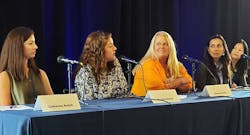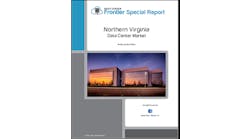Women of Mission Critical: Diversity Key to Data Center Industry’s Future
LEESBURG, Va. – In a conference circuit with “manels” aplenty, how about a data center conference featuring only women?
That was the principle behind CAPRE’s Women in Mission Critical Conference earlier this month, with the theme of “Awareness, Leadership and Mentoring.”
As with any data center conference, there were insights about business trends and operations and financing. But there were also sessions focused on inspiration and encouragement, and lots of real talk about the value of diversity and the urgent need to create more opportunities for women in the data center, the C-suite and the board room.
Women represent a small percentage of the workforce in the data center industry, and about 20 percent of all technology jobs, according to Rima Raouda, VP and Research Director for the CAPRE Data Center Series, and the producer for the event at Stone Tower Winery.
“We know the data center industry is facing a skills shortage,” said Raouda. “The industry is dominated by white males.”
As data center staffing challenges have become more acute, the industry has begun taking steps to address its outsized gender gap, including conference panels and diversity initiatives by Infrastructure Masons and the 7×24 Exchange International, among others.
Moving Beyond Talk
A consistent message at the conference was that more diversity will be good for business, providing opportunities for skilled workers to address the looming jobs crisis, as well as new perspectives on strategy and decision-making. Women comprise 51 percent of the population, representing the data center industry’s largest example of underutilization.
But progress remains slow, and women in the industry are focused on action, not just talk.
“I’m not going to wait to be included,” said Jezzibell Gilmore, the co-founder and Senior VP of Business Development at Packet Fabric. “I’m going to get involved. Do it yourself.
Jezzibell Gilmore, co-founder of Packet Fabric, speaks at the CAPRE Women of Mission Critical conference. (Photo: Rich Miller)
“I’m not white. I’m female. I speak with an accent,” Gilmore continued. “But to do what I want to do, I take charge. And so should you.”
“I’m all about disrupting the business,” said Nancy Novak, the Senior VP of Construction at Compass Datacenters. “All these things that get in the way of diversity … that all needs to be disrupted.”
Part of the process is educating others, especially the men that make most of the decisions on hiring and promotion.
“It’s about training up leaders,” said Novak. “Men are the leaders, but you haven’t changed how you think or how you act. Put on different lenses. Stop trying to change the people applying for jobs, and instead try to change the business.”
That sentiment was echoed by Heather Dooley, the Chief of Staff of Data Center Business Operations at Google.
“It’s everyone in this room’s responsibility to raise awareness, and that’s just the first step,” said Dooley. “I work closely with my recruiters, and adjust their lenses. I think it’s our job to educate people on the front line and help them adjust their perspectives.”
Amy Marks speaks at the CAPRE Women of Mission Critical Conference, held Sept. 9 in Leesburg, Virginia. Looking on at left is Stephanie Joshi of Microsoft Azure. (Photo: Rich Miller)
Amy Marks, the CEO of Xsite Modular, said addressing diversity requires not just education and mentoring but sponsorship – having allies that will provide contracts and even financing to women-led companies. XSite has built prefabricated cable landing stations and modular data centers across the globe.
Dooley agreed. “We have to change incentives for general contractors to hire women-owned businesses, ” she said.
One data center industry standout in the diversity of its executive team has been Switch, where women represent more than half of its leadership team, including C-suite positions.
Conferences as an Avenue for Progress
Technology conferences have been a key venue in which women have fought for access and respect. Many tech conferences continue to feature all-male panels, and research by Ensono found that women represent just 17 percent of speakers at large conferences. More than 70 percent of women on technical panels said they were the sole female panelist.
There have also been high-profile incidents of harassment at conferences. One in four women who have attended a tech conference report experiencing sexual harassment, according to the Ensono research. This has led many leading tech conference to adopt codes of conduct clarifying acceptable behavior at their events.
For many years, most data center conferences were attended by only a handful of women. (Editor’s note: I experienced this first-hand while attending dozens of conferences with my wife Colleen when she was an executive on the Data Center Knowledge team).
In recent years, data center conferences have made substantial progress. The 7×24 Exchange, DatacenterDynamics, Data Center World and CAPRE have featured all-women panels in their events, which importantly have included technical panels as well as sessions focused on diversity.
Some of the attendees at the CAPRE Women in Mission Critical event at Stone Tower Winery in Leesburg, Va. (Photo: Rich Miller).
CAPRE opted to go a step further, creating a forum entirely for women in the data center industry. For some panelists, the room was a welcome change from the usual conference environment.
“I love the fact that there are a few men mixed in with hundreds of women,” said Tina Gravel, the SVP of Channels and Alliances at Cyxtera Technologies. “I am thrilled with this audience.”
The Winding Path to the Cloud
The keynote speaker was Shannon Hulbert, the CEO of Opus Interactive, whose presentation was titled “From the End of the Road to the Information Superhighway.” Hulbert grew up in a small California town called End of the Road on the Yurok Native American Reservation. Her home had no energy or connectivity, and Hulbert recalls watching a TV powered by a car battery.
Keynote speaker Shannon Hulbert, CEO of Opus Interactive. (Photo: Rich Miller)
Hulbert’s path to the data center included jobs as a wildland firefighter, mill worker, graphic designer, and an energy conservation specialist. She wound up as a marketing executive at Opus Interactive, an IT company that started life inside a creative agency. Opus specializes in government and healthcare cloud hosting, with data center operations in Portland, Dallas and Manassas, Virginia.
“We may be small, but so is Seal Team Six,” said Hulbert. “So we’re like the Seal Team Six of cloud computing.
“Connecting people with technology is our life’s work,” she added. “There’s so much opportunity.”
Noting the statistics on women in technology, Hulbert noted that she represented “the statistical anomaly – in good shoes.”
The Road Ahead
Hulbert hopes her story, and others like it, can serve as a model for other young women considering a career in technology. She noted surveys that at age 11, about 80 percent of girls are interested in STEM (Science, Technoloy, Engineering and Math) curriculum. By age 13, that number drops to about 13 percent.
“If a little girl from the End of the Road, with no energy or connectivity, can become a Native American woman tech CEO, then who knows how far the women in mission critical of the next generation can go!”
Google’s Dooley says the data center industry will be undergoing change as next-generation technologies take hold. The road ahead presents an opportunity for disruption for those who can adapt.
“We’re in the fourth industrial revolution,” said Dooley. “It’s an opportunity for everyone who wants to participate. I look at it as a real game changer. You all have an opportunity to bring new talent into your data center. It’s an opportunity for all of you to learn new skills.
“Find your voice – for the industry, for one another, and for yourself,” said Dooley.






